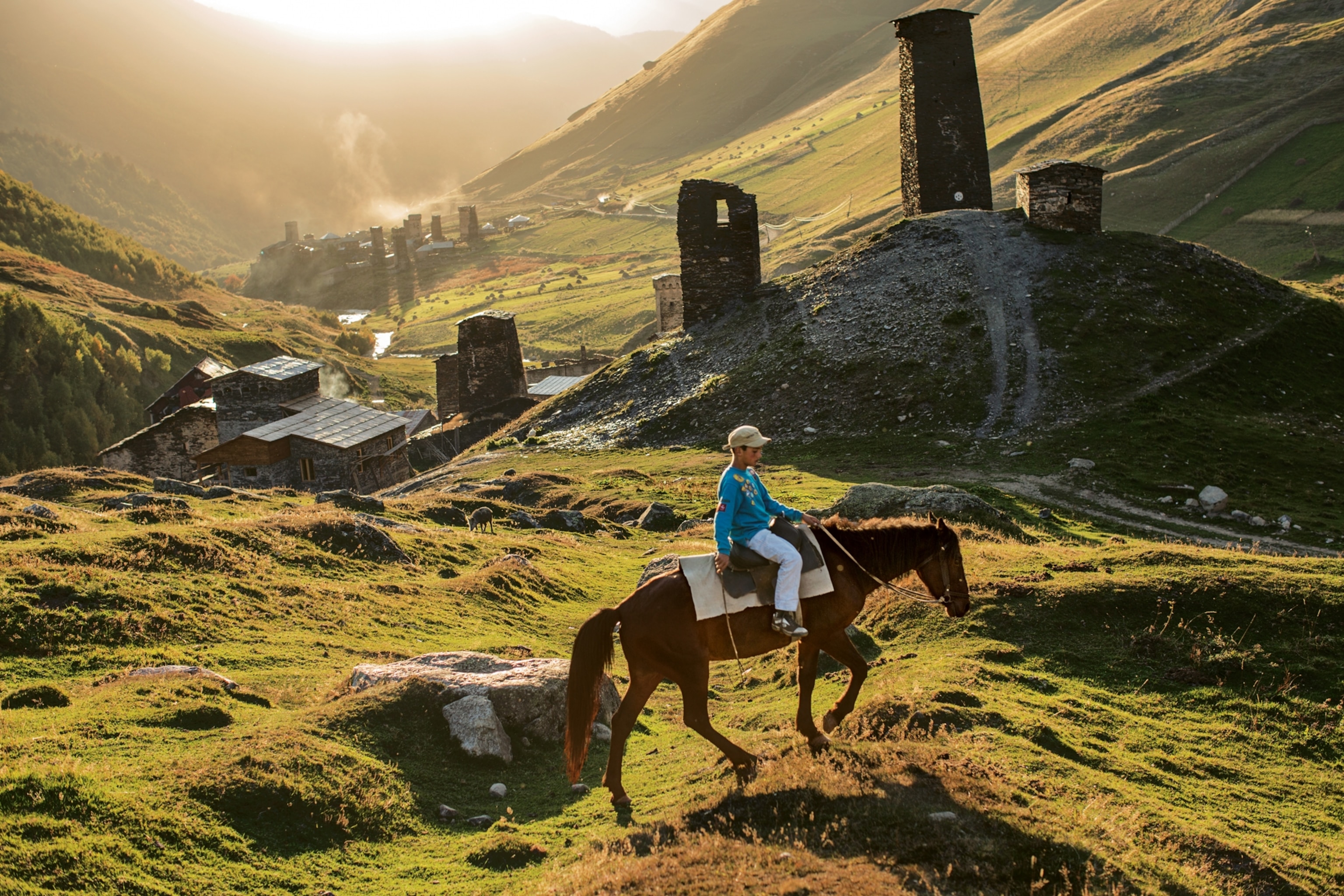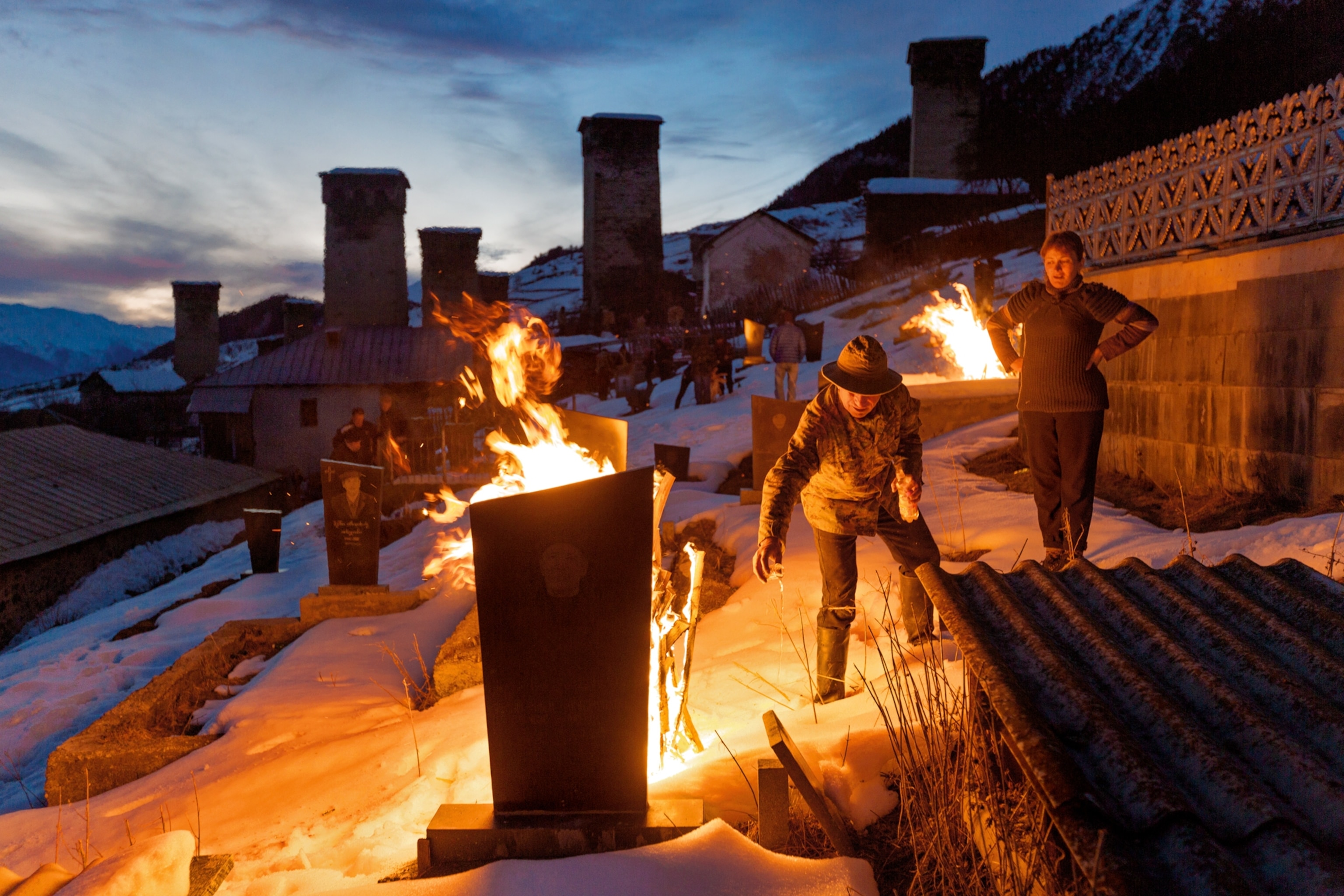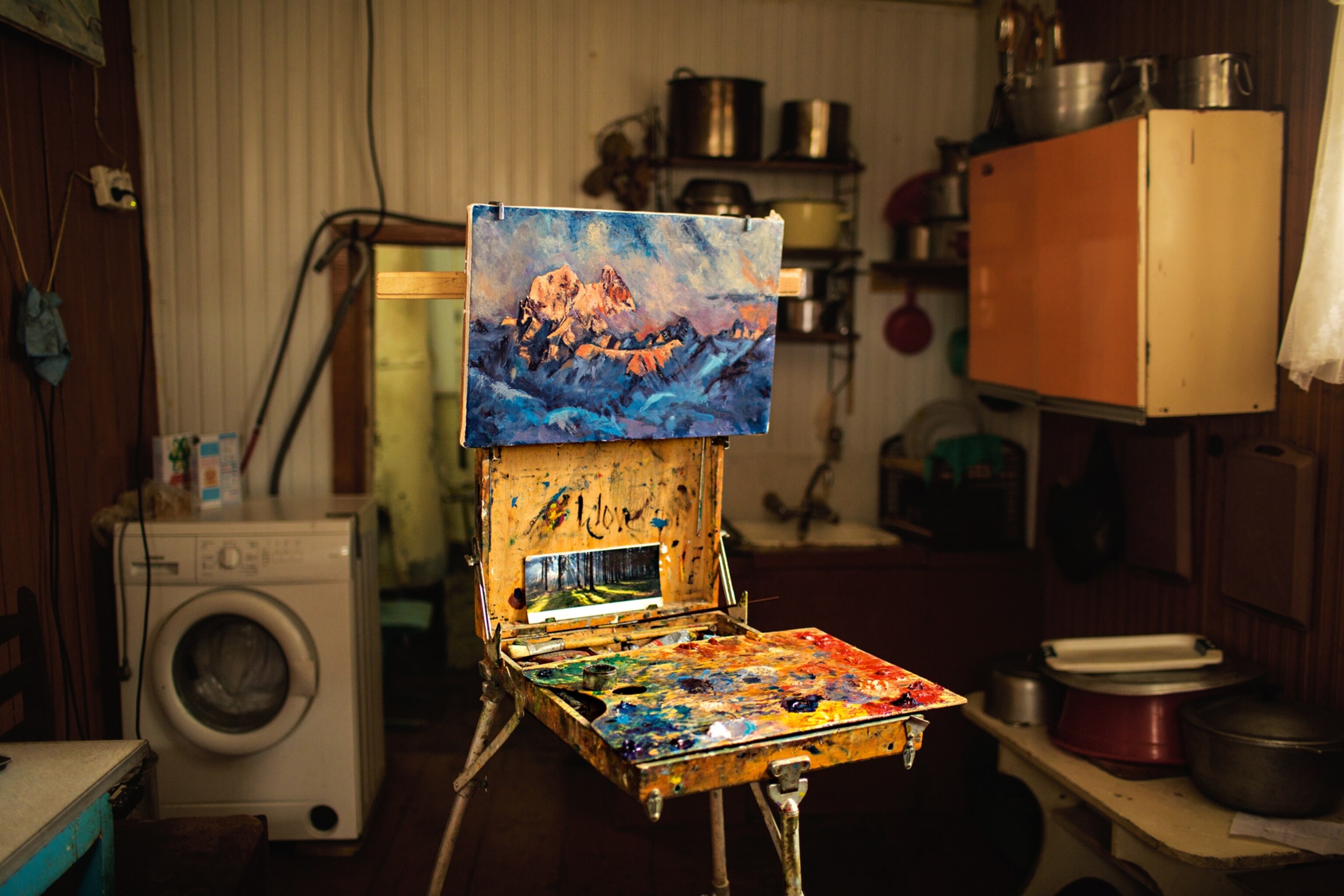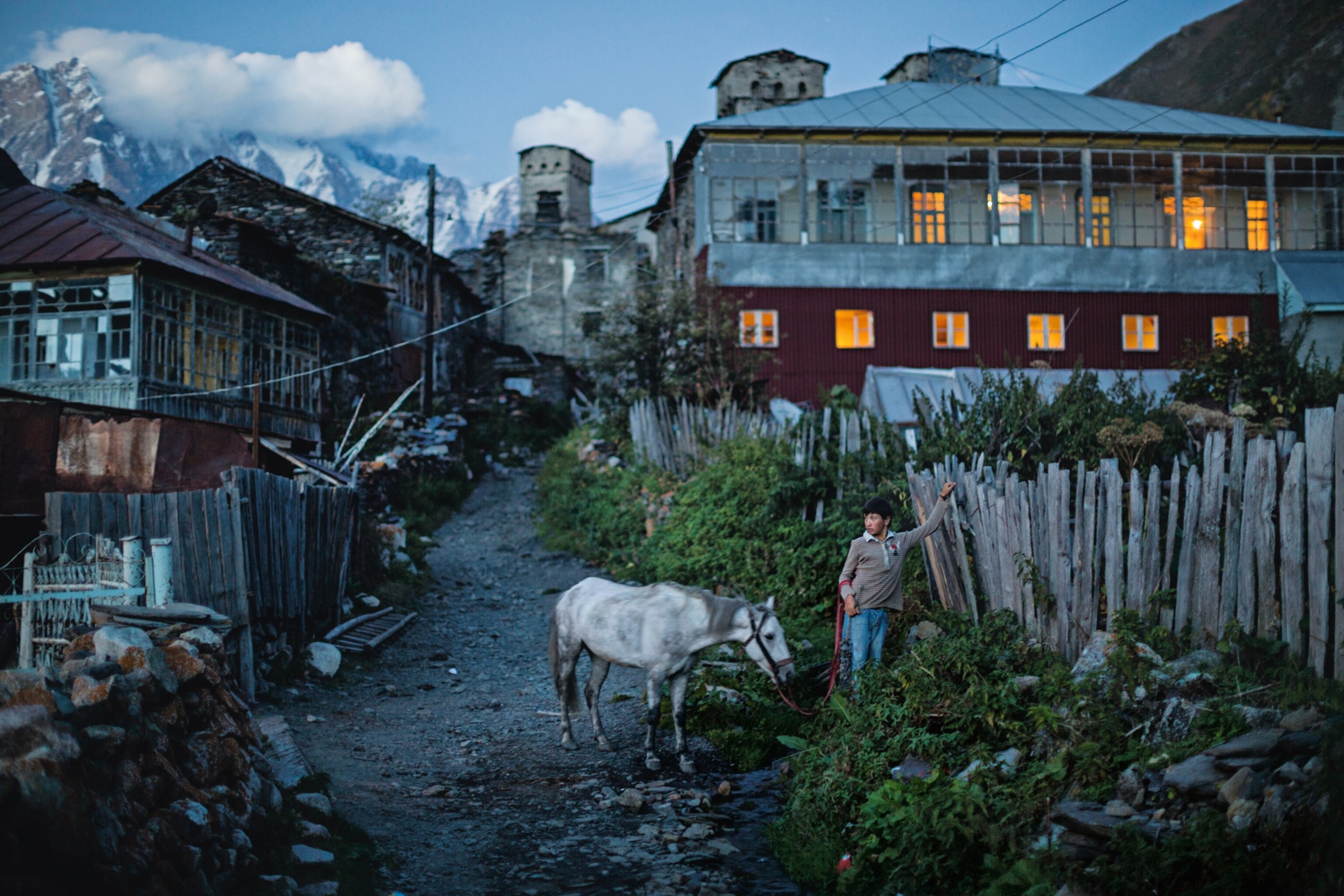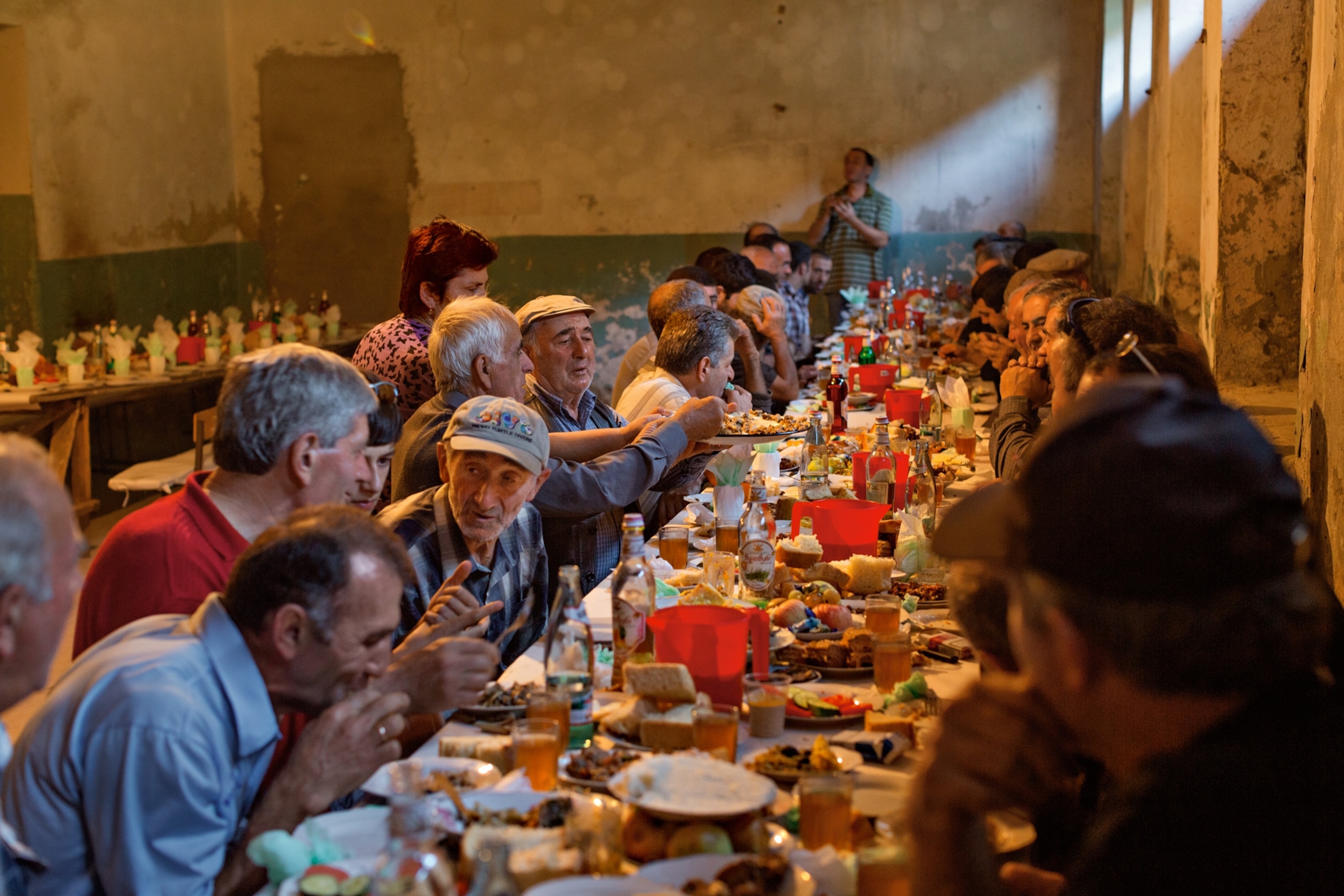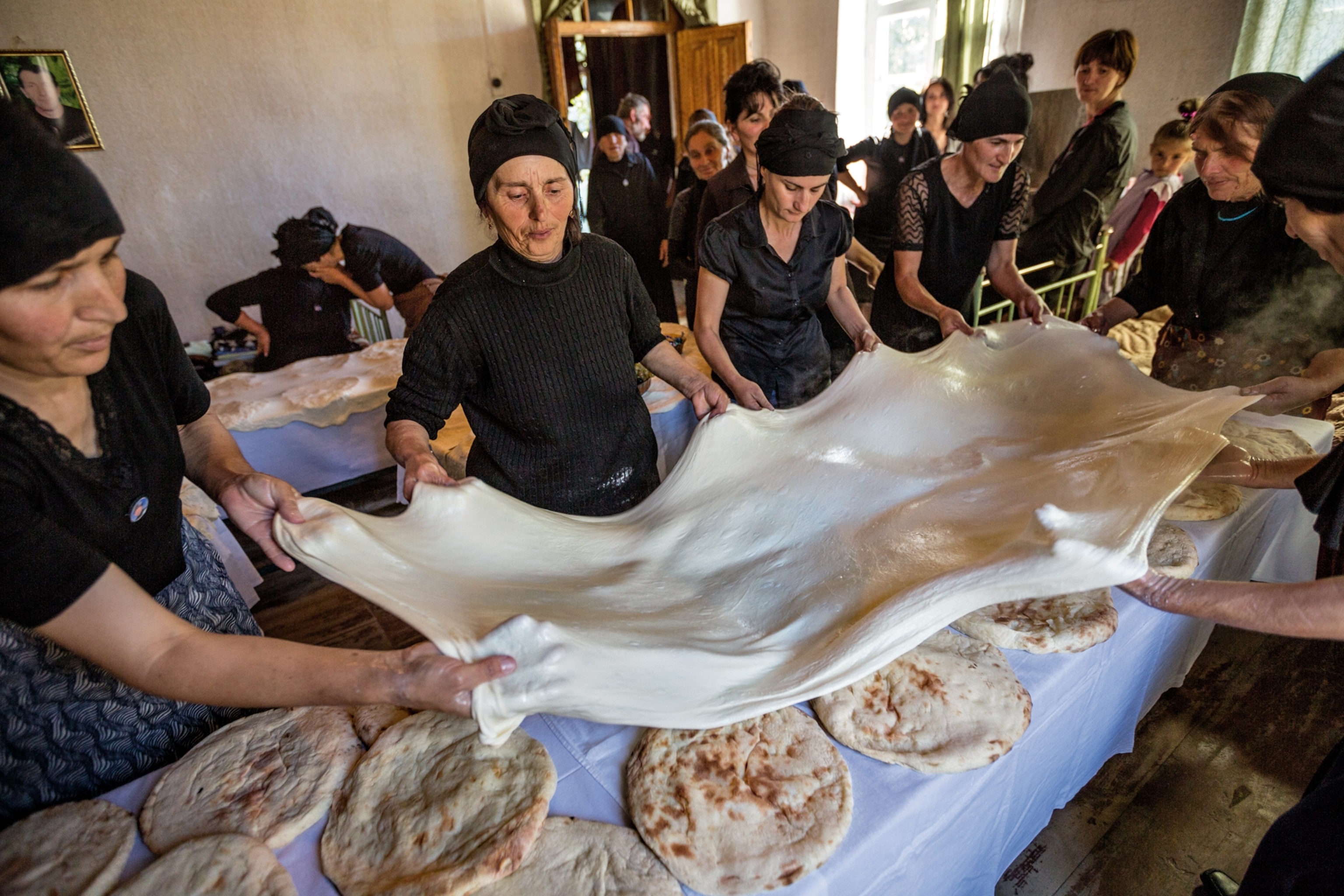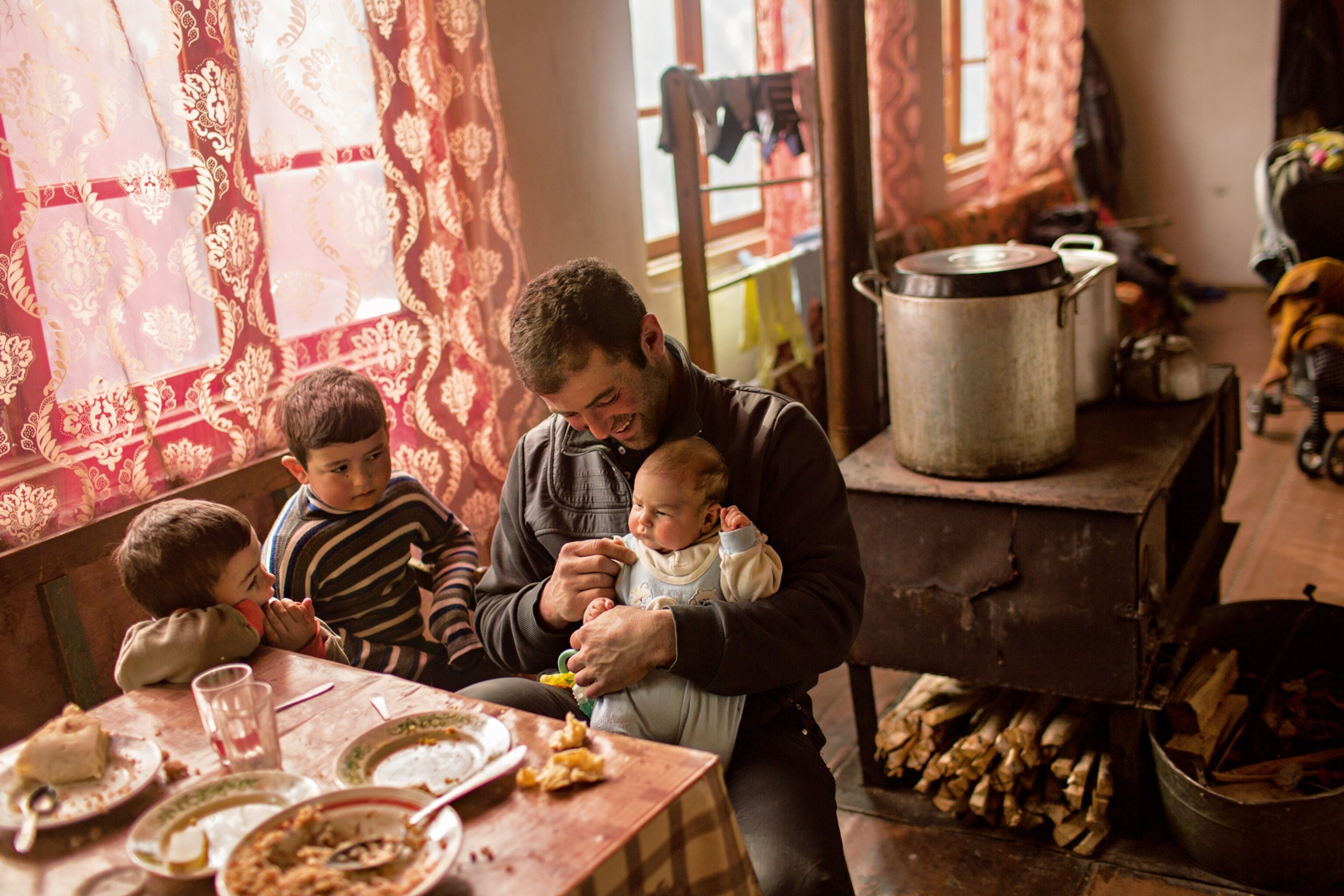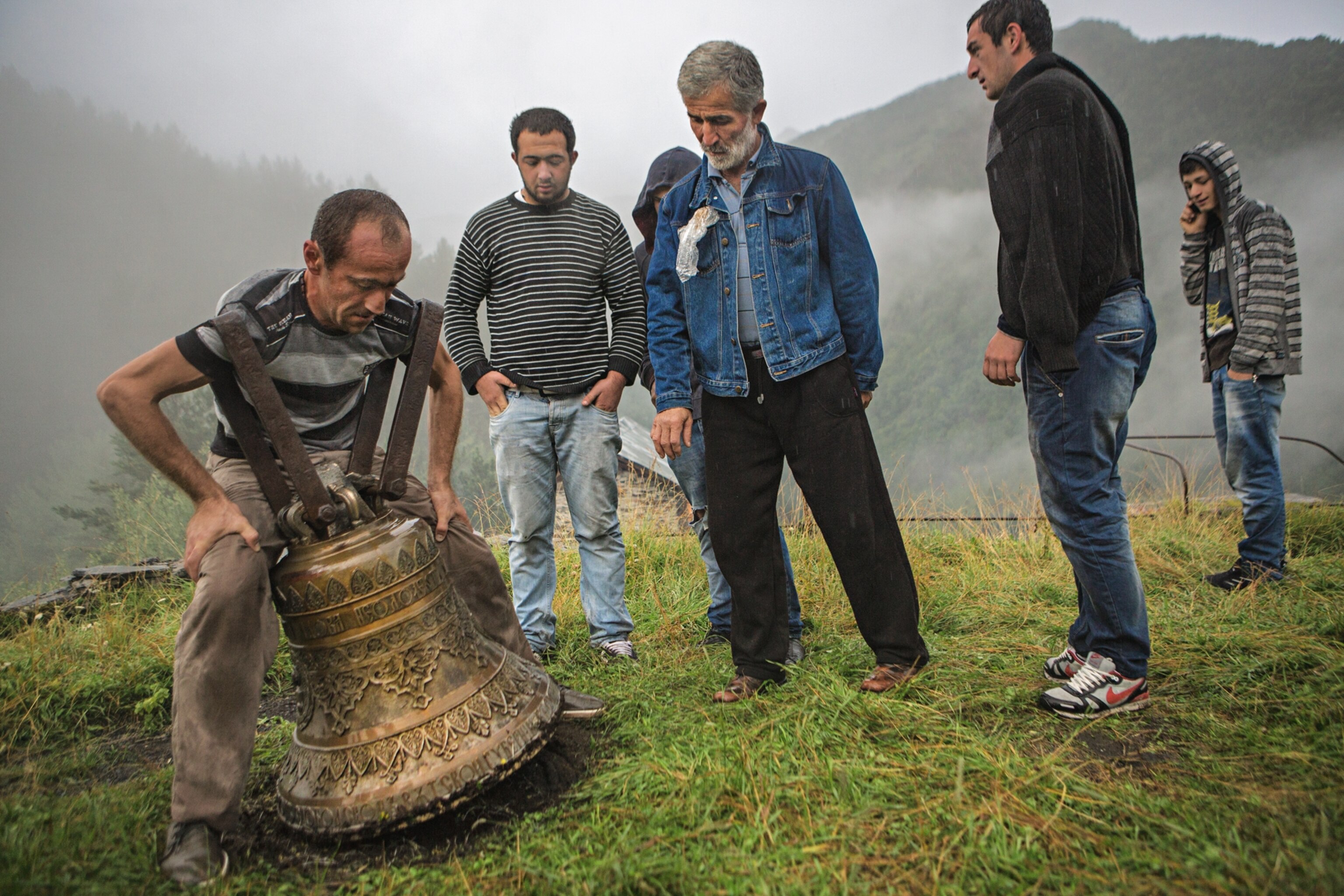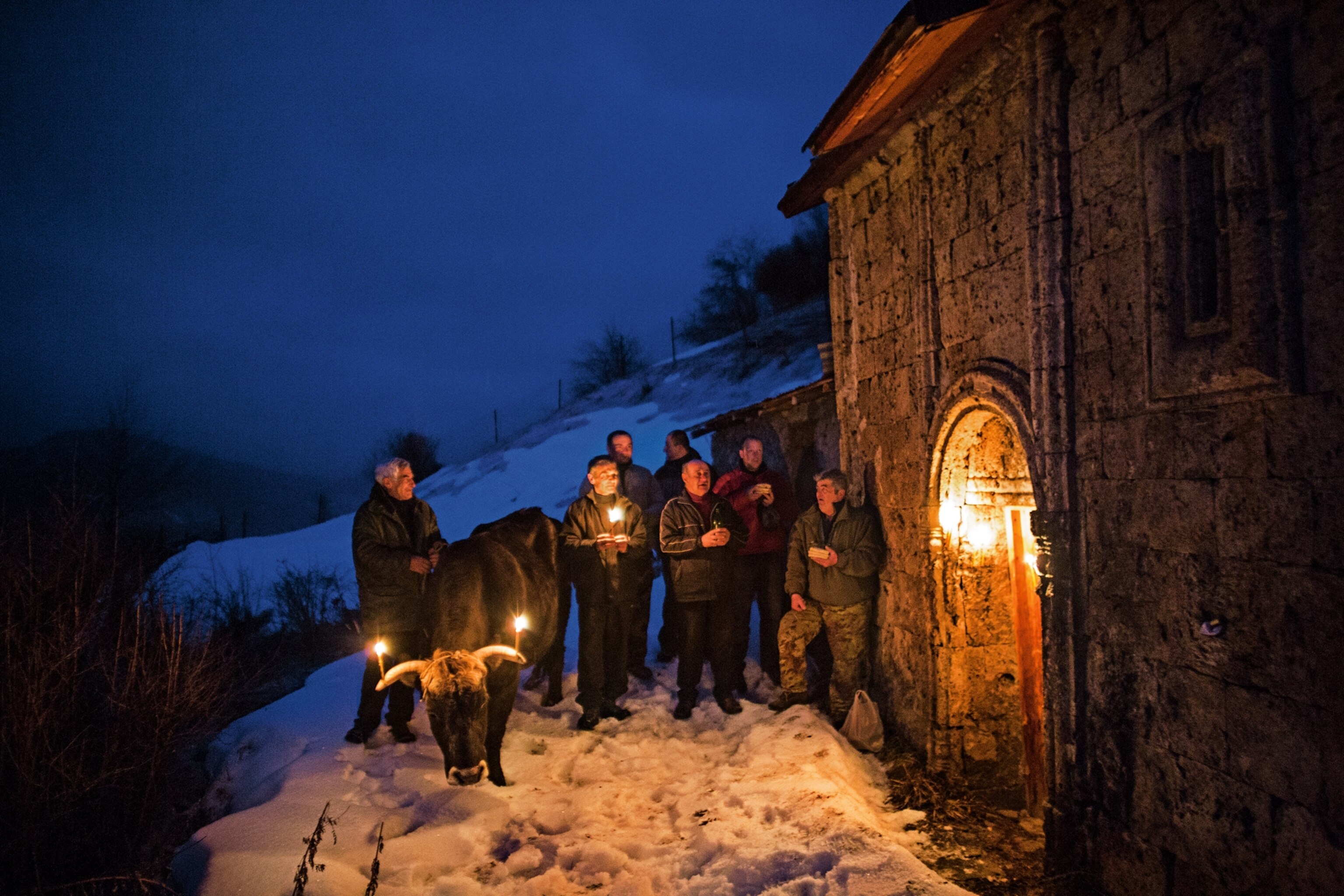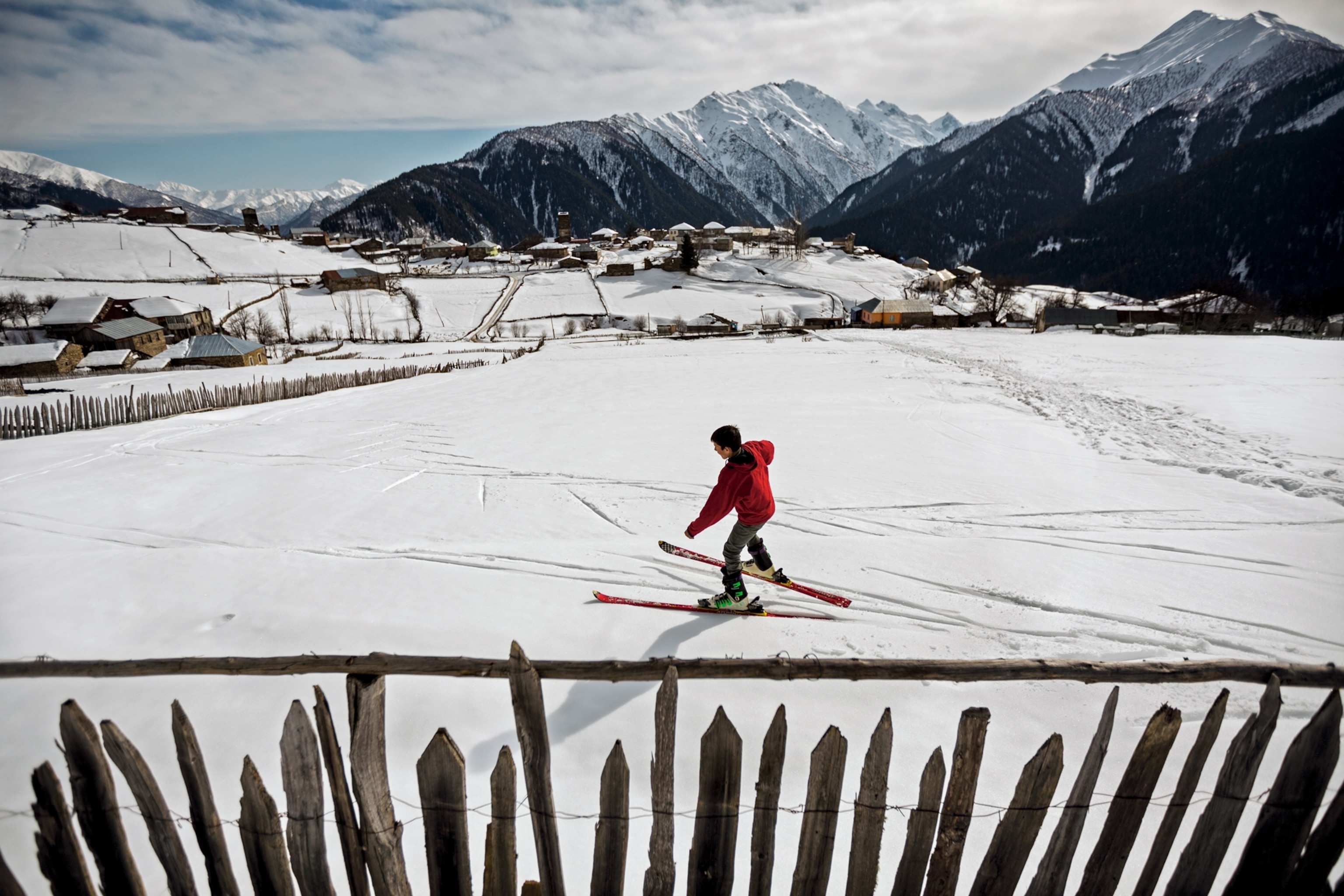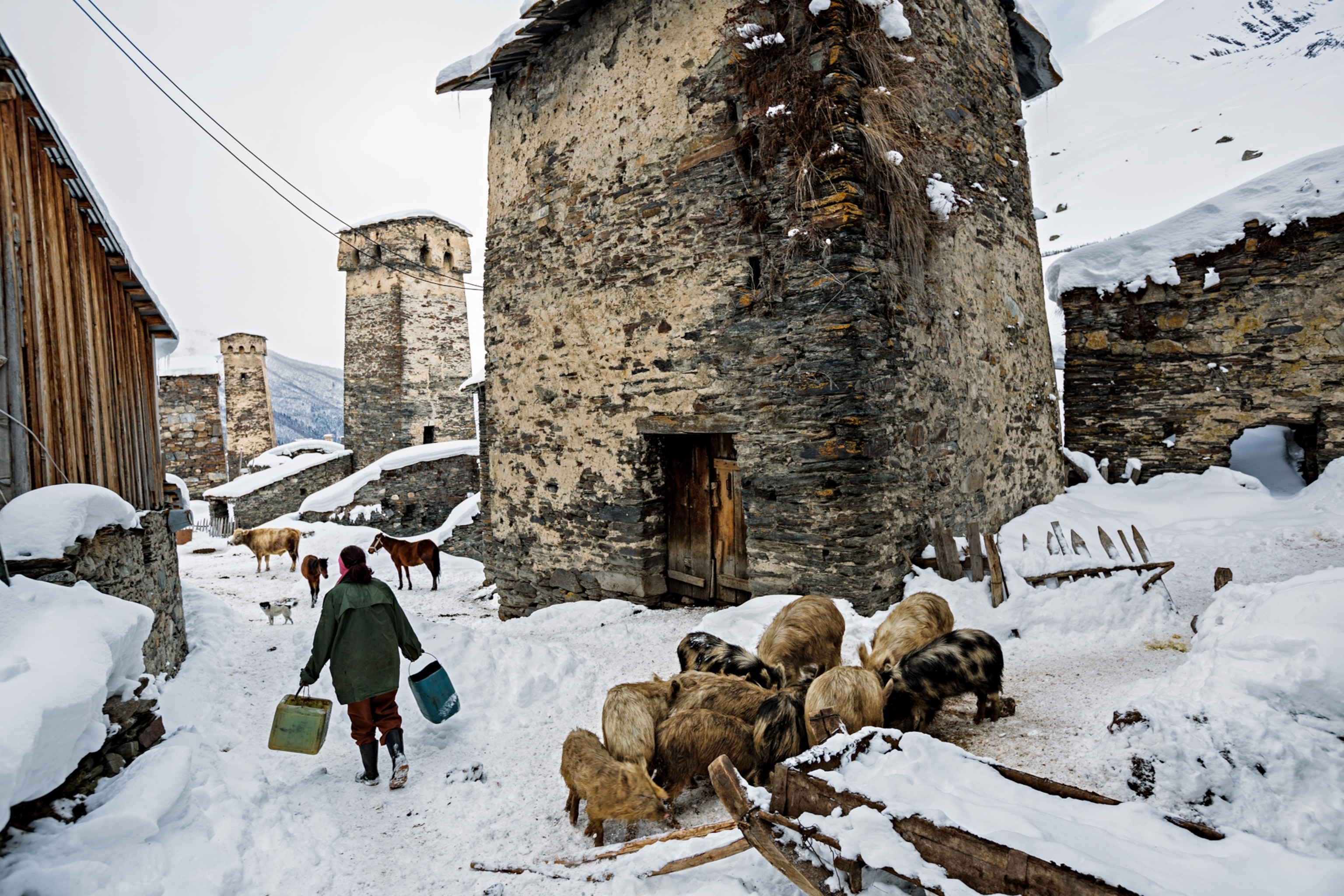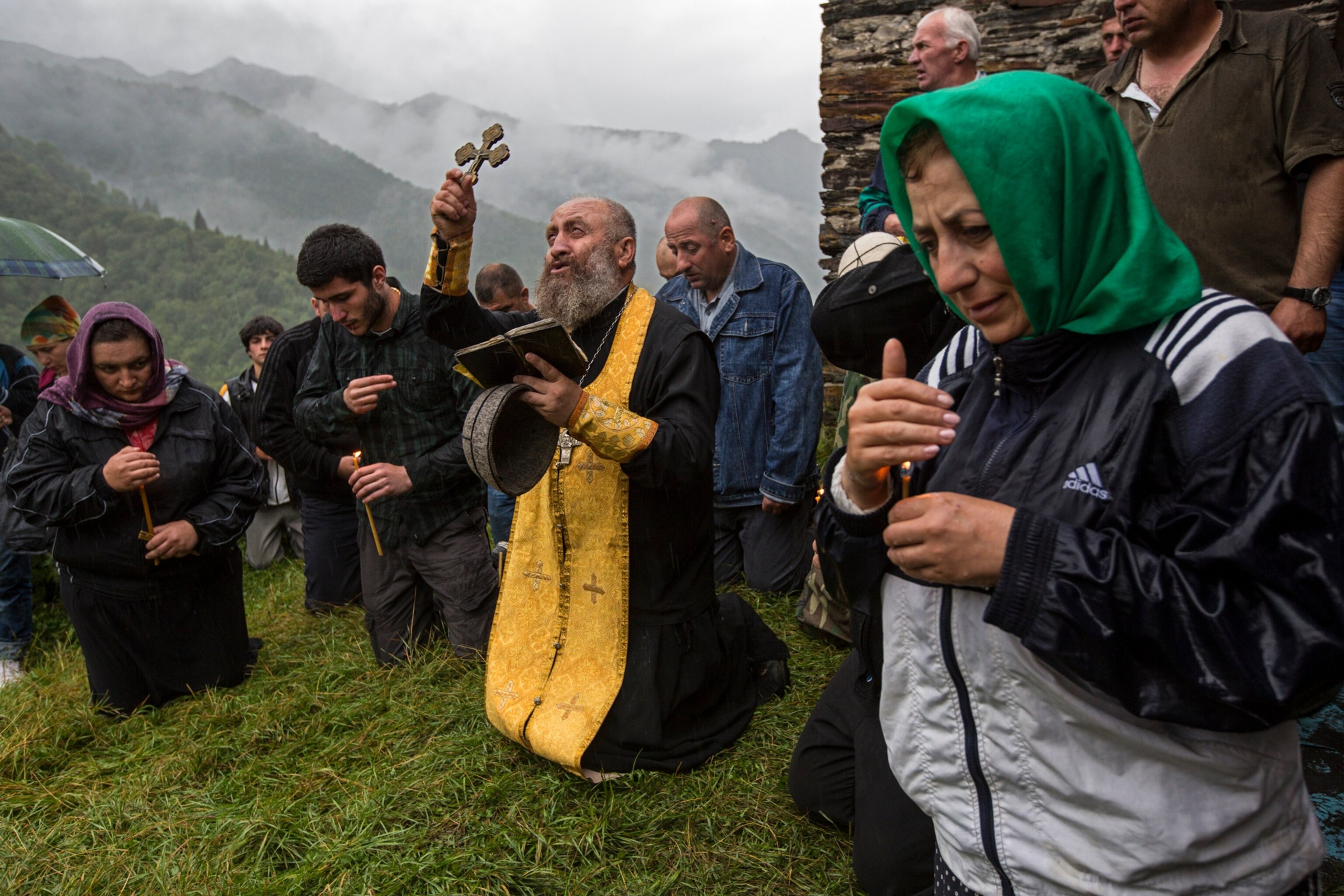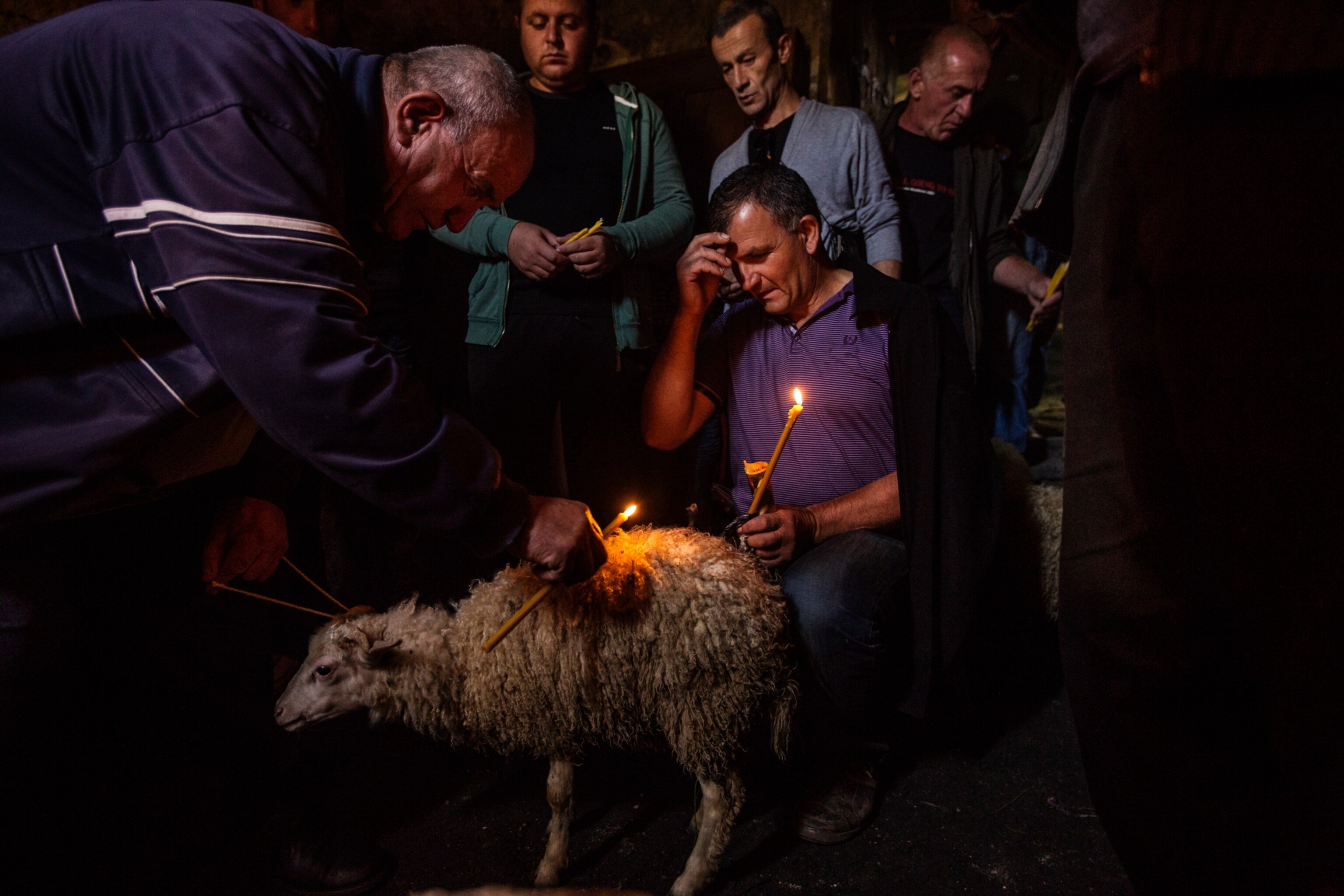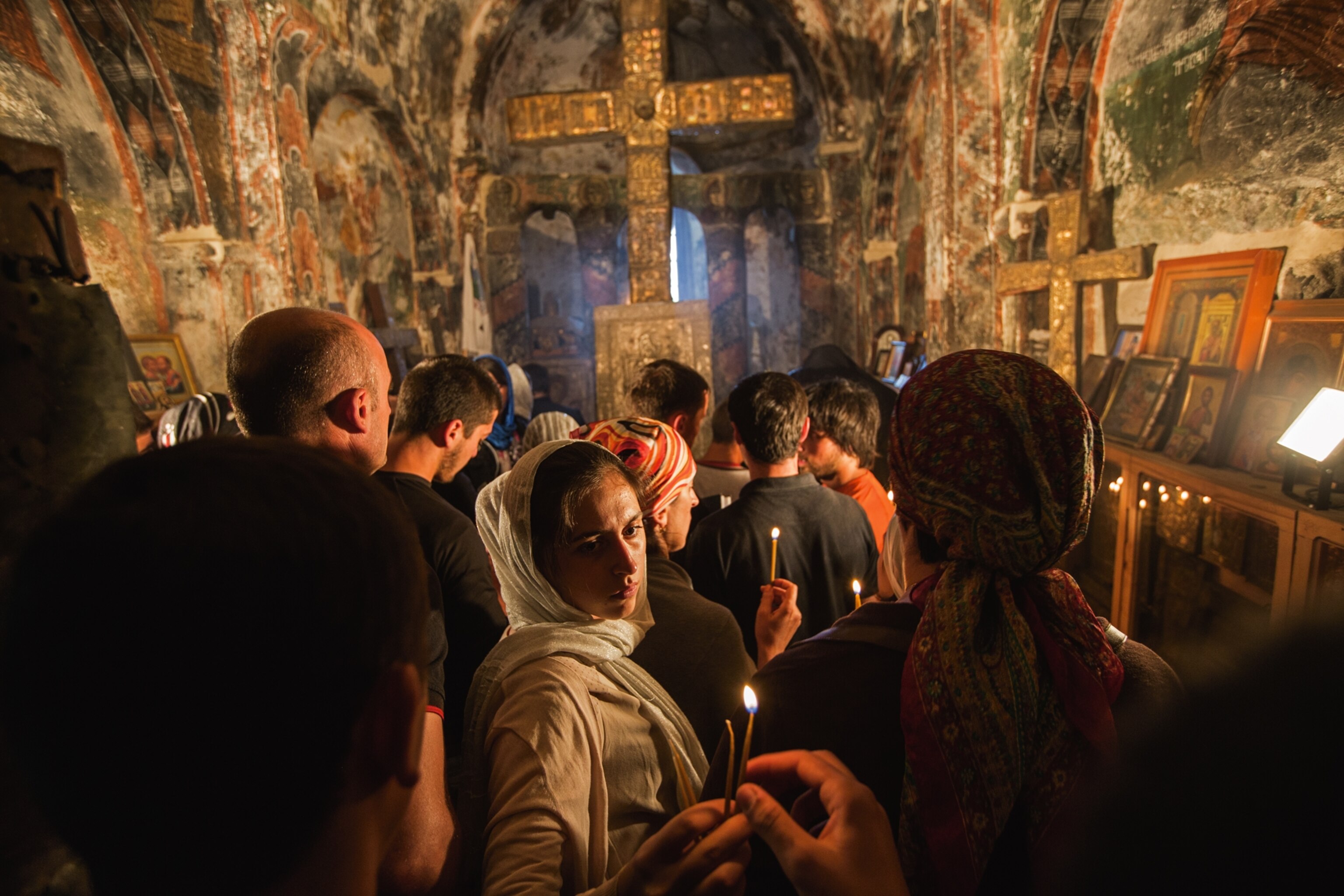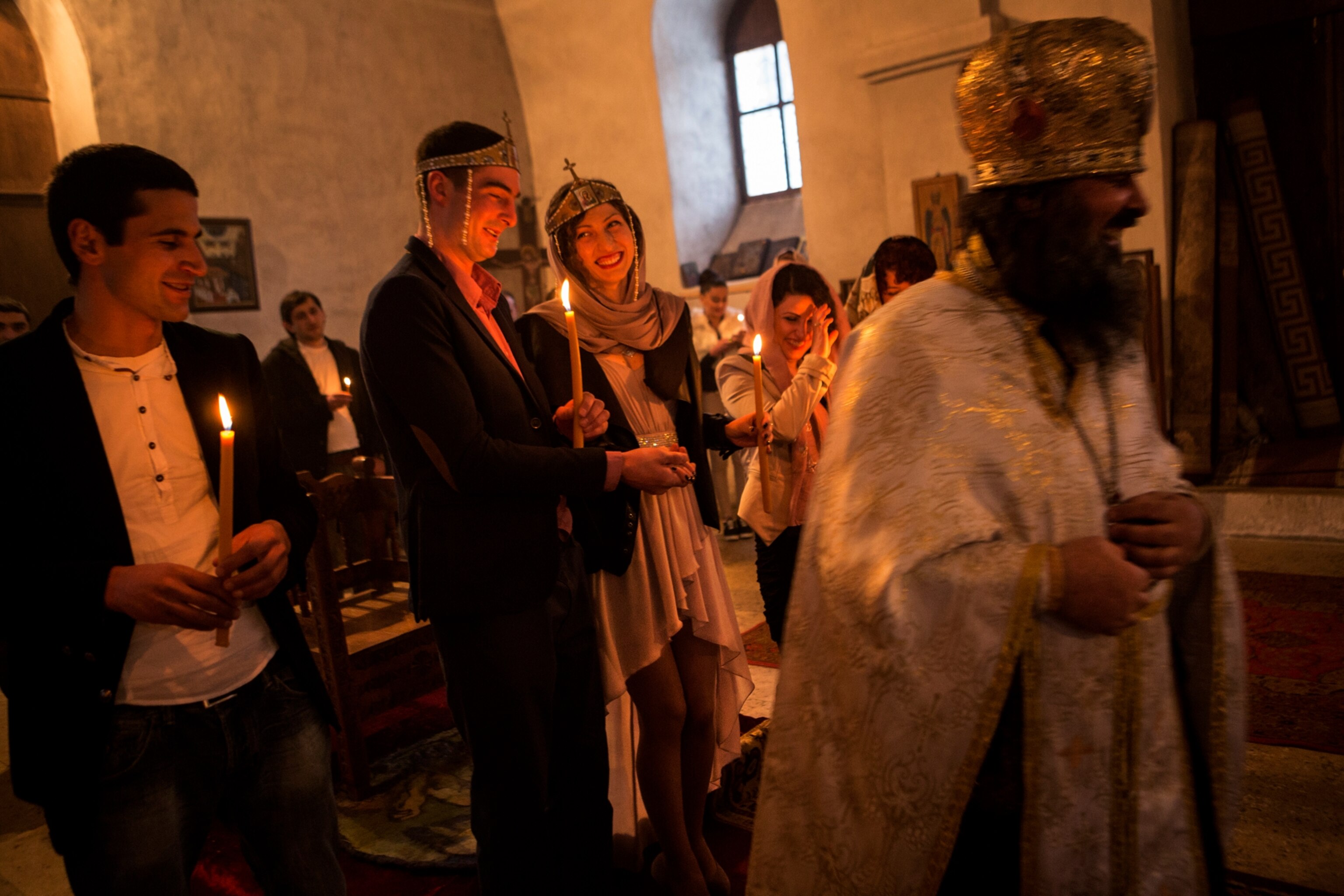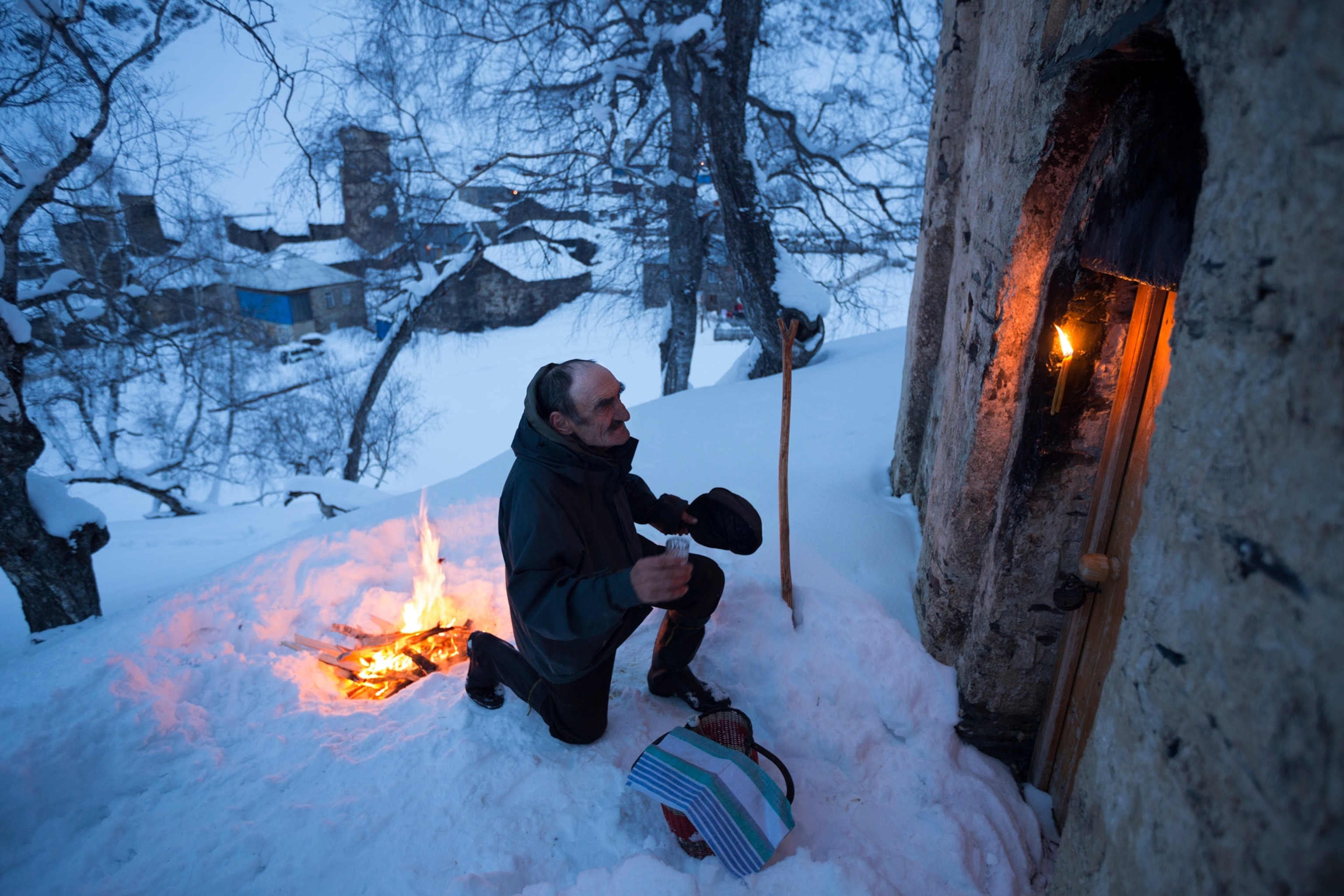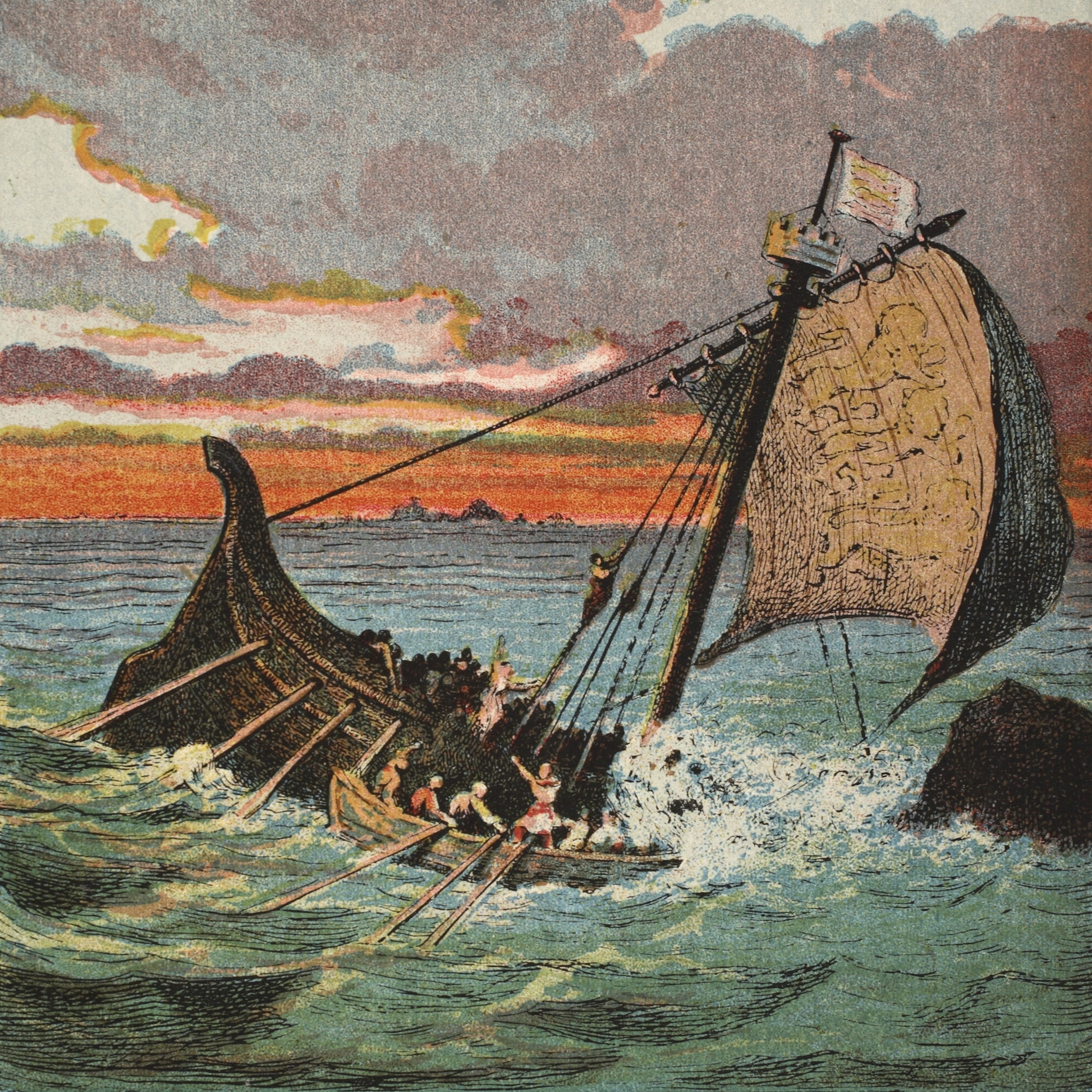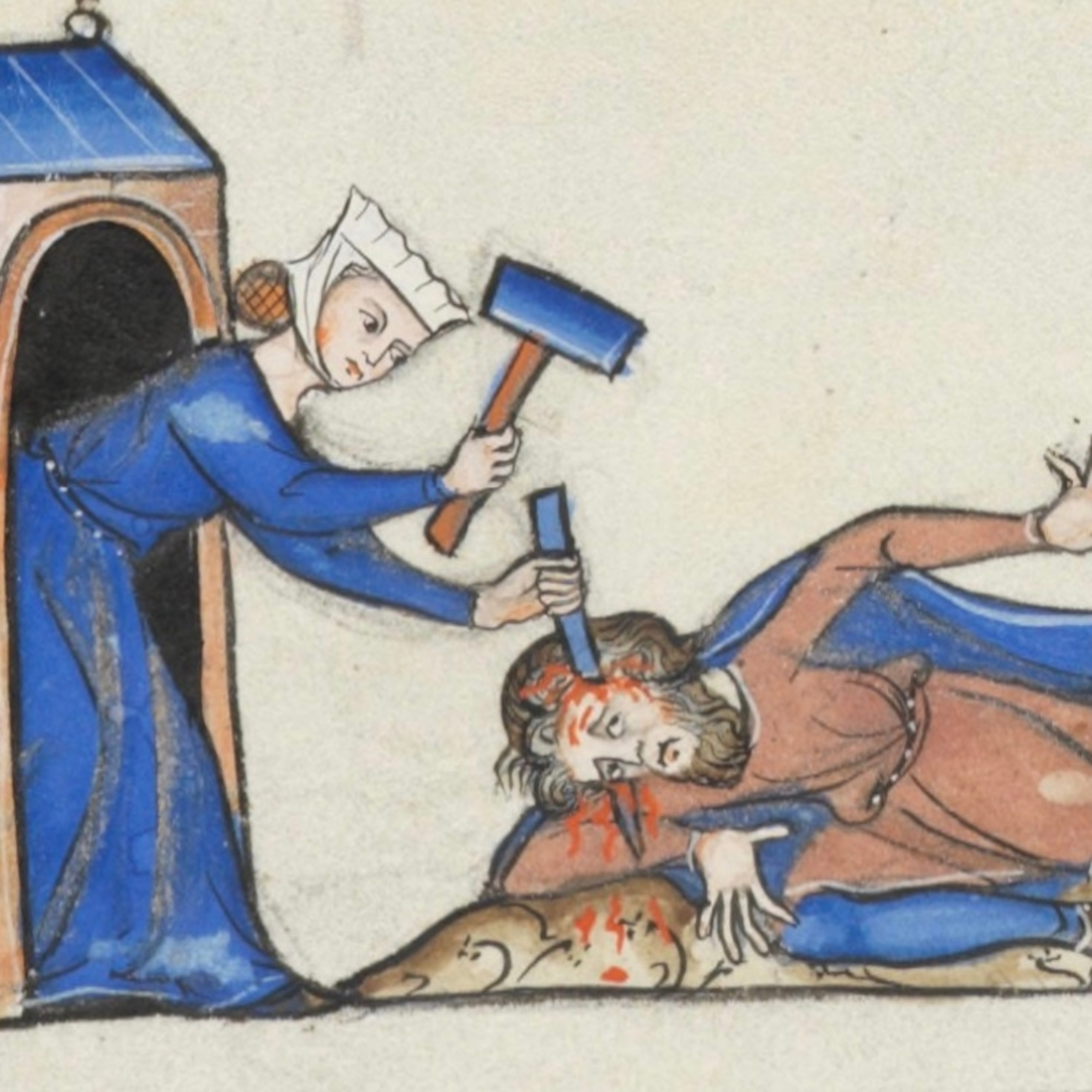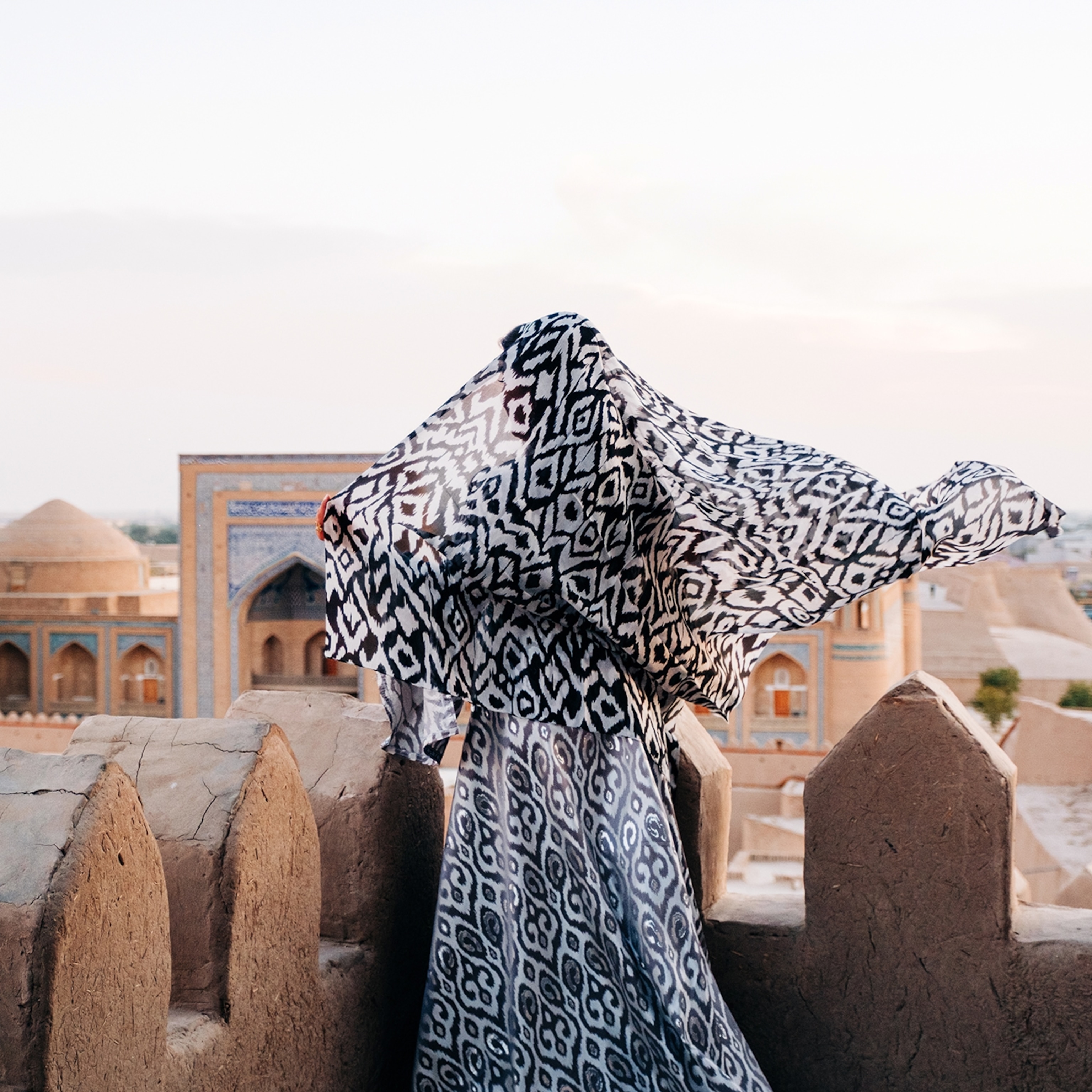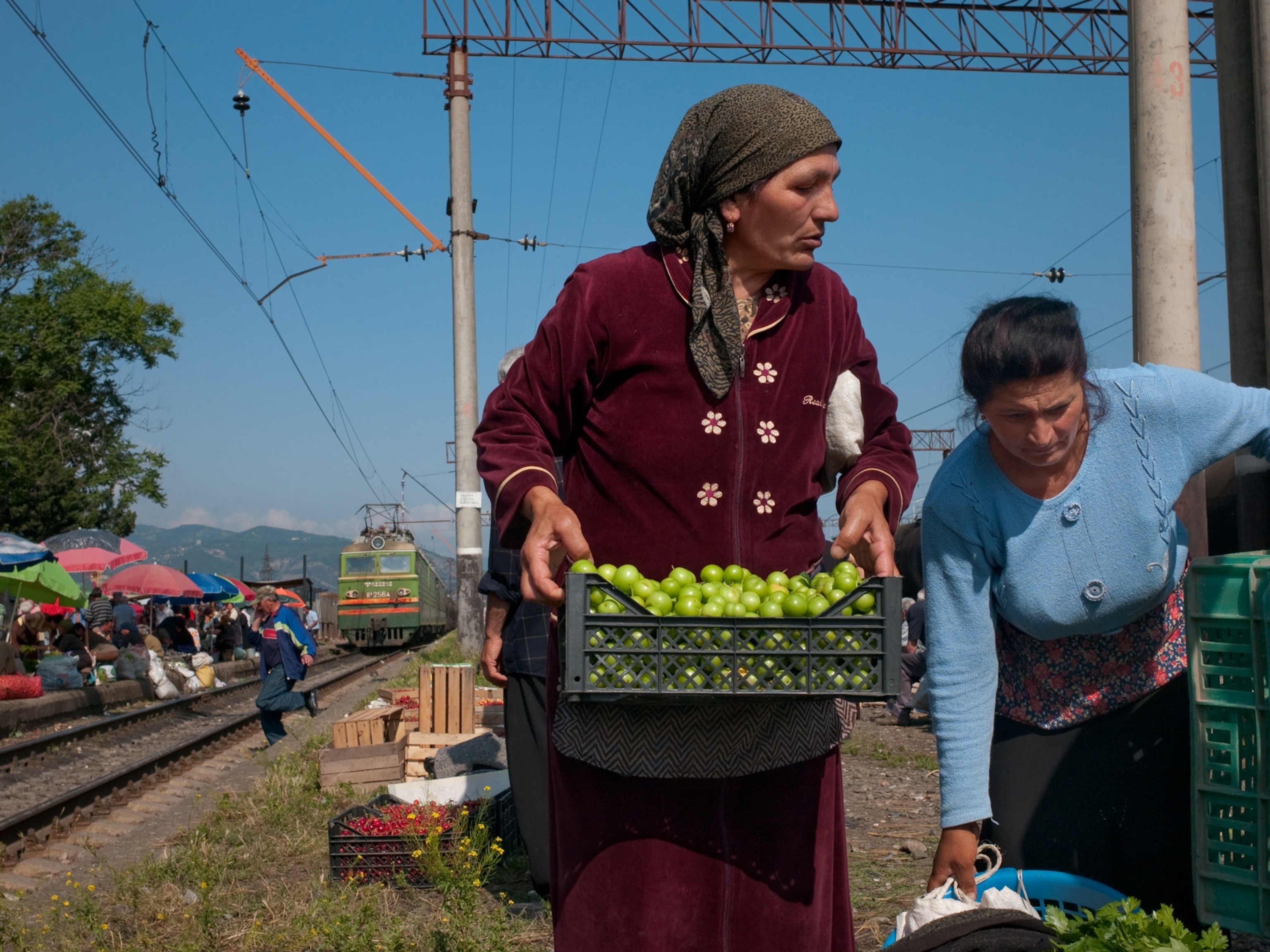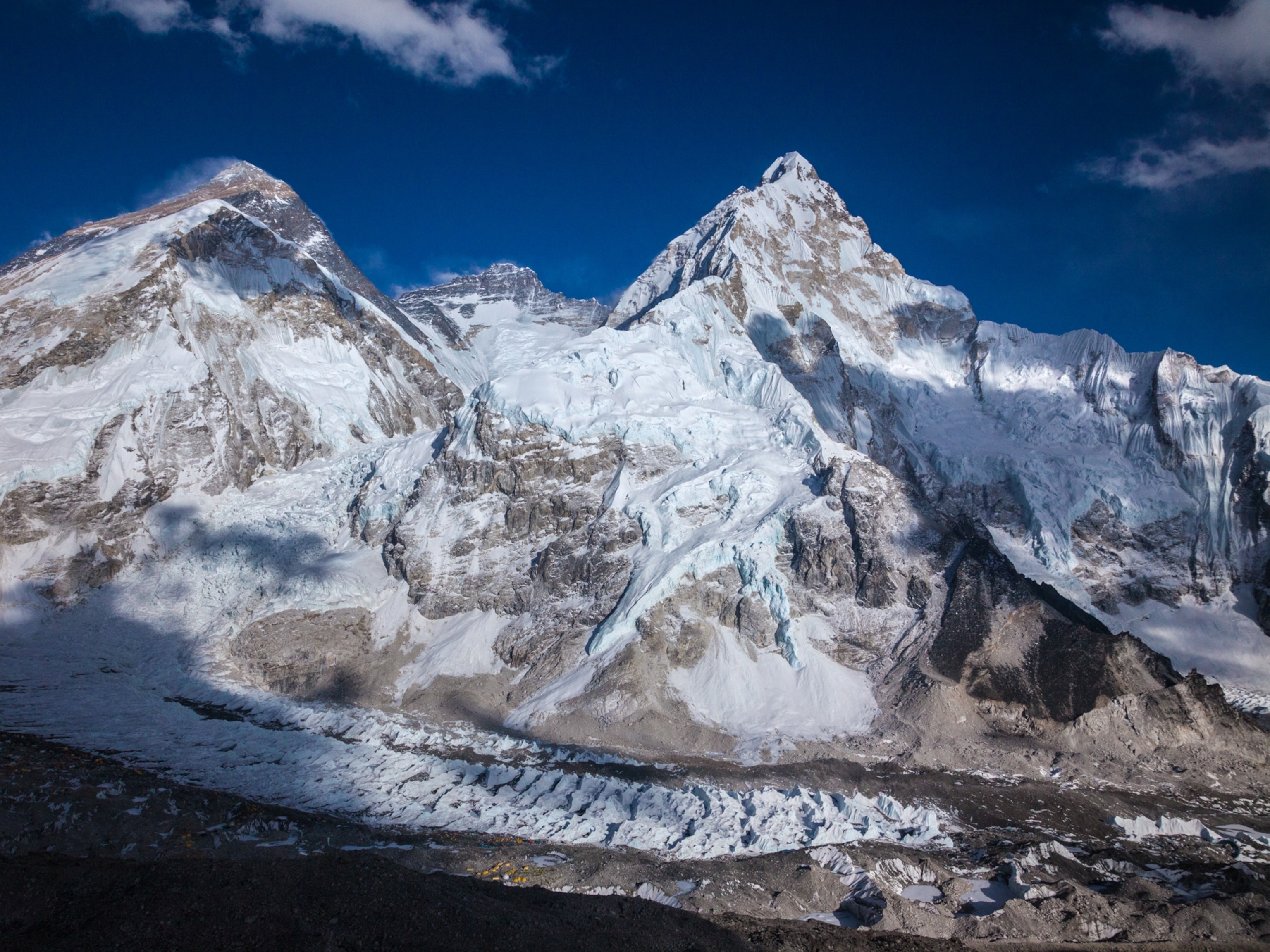Medieval Mountain Hideaway
In Svaneti, high in Georgia’s Caucasus Mountains, centuries-old defensive towers loom over remote villages.
The men gather at dawn near the stone tower, cradling knives in callused hands. After a night of snowfall—the first of the season in Svaneti, a region high in Georgia’s Caucasus Mountains—the day has broken with icy clarity. Suddenly visible above the village of Cholashi, beyond the 70-foot-high towers that form its ancient skyline, is the ring of 15,000-foot peaks that for centuries has kept one of the last living medieval cultures barricaded from the outside world.
Silence falls as Zviad Jachvliani, a burly former boxer with a salt-and-pepper beard, leads the men—and one recalcitrant bull—into a yard overlooking the snow-dusted valley. No words are needed. Today is a Svan feast day, ormotsi, marking the 40th day after the death of a loved one, in this case Jachvliani’s grandmother. The men know what to do, for Svan traditions—animal sacrifices, ritual beard cutting, blood feuds—have been carried out in this wild corner of Georgia for more than a thousand years. “Things are changing in Svaneti,” Jachvliani, a 31-year-old father of three, says. “But our traditions will continue. They’re part of our DNA.”
In the yard he maneuvers the bull to face east, where the sun has crept above the jagged crown of Mount Tetnuldi, near the Russian border. Long before the arrival of Christianity in the first millennium, Svans worshipped the sun, and this spiritual force—along with its derivative, fire—still figures in local rituals. As the men with knives gather in front of him, Jachvliani pours a shot of moonshine on the ground, an offering to his grandmother. His elderly uncle chants a blessing. And then his cousin, cupping a candle against the wind, lights the hair on the bull’s forehead, lower back, and shoulders. It is the sign of the cross, rendered in fire.
After the blessing, the men lasso one of the bull’s legs with a rope and, heaving in unison, truss the bellowing beast over the branch of an apple tree. Jachvliani grabs its horns, while another villager, unsheathing a sharpened dagger, kneels down next to the bull and, almost tenderly, feels for the artery in its neck.
Over the course of history many powerful empires—Arab, Mongol, Persian, Ottoman—sent armies rampaging through Georgia, the frontier between Europe and Asia. But the home of the Svans, a sliver of land hidden among the gorges of the Caucasus, remained unconquered until the Russians exerted control in the mid-19th century. Svaneti’s isolation has shaped its identity—and its historical value. In times of danger, lowland Georgians sent icons, jewels, and manuscripts to the mountain churches and towers for safekeeping, turning Svaneti into a repository of early Georgian culture. The Svans took their protective role seriously; an icon thief could be banished from a village or, worse, cursed by a deity.
In their mountain fastness the people of Svaneti have managed to preserve an even older culture: their own. By the first century B.C. the Svans, thought by some to be descendants of Sumerian slaves, had a reputation as fierce warriors, documented in the writings of the Greek geographer Strabo. (Noting that the Svans used sheepskins to sift for gold in the rivers, Strabo also fueled speculation that Svaneti might have been the source of the golden fleece sought by Jason and the Argonauts.) By the time Christianity arrived, around the sixth century, Svan culture ran deep—with its own language, its own densely textured music, and complex codes of chivalry, revenge, and communal justice.
If the only remnants of this ancient society were the couple of hundred stone towers that rise over Svan villages, that would be impressive enough. But these fortresses, built mostly from the 9th century into the 13th, are not emblems of a lost civilization; they’re the most visible signs of a culture that has endured almost miraculously through the ages. The Svans who still live in Upper Svaneti—home to some of the highest and most isolated villages in the Caucasus—hold fast to their traditions of singing, mourning, celebrating, and fiercely defending family honor. “Svaneti is a living ethnographic museum,” says Richard Bærug, a Norwegian academic and lodge owner who’s trying to help save Svan, a largely unwritten language many scholars believe predates Georgian, its more widely spoken cousin. “Nowhere else can you find a place that carries on the customs and rituals of the European Middle Ages.”
What happens, though, when the Middle Ages meet the modern world? Since the last years of Soviet rule a quarter century ago, thousands of Svans have migrated to lowland Georgia, fleeing poverty, conflict, natural disasters—and criminal gangs. In 1996, when UNESCO bestowed World Heritage status on the highest cluster of Svan villages, Ushguli, the lone road that snakes into Svaneti was so terrorized by bandits that few dared to visit. Security forces busted the gangs in 2004. And now the government is implementing a plan to turn this medieval mountain zone into a tourist magnet.
Svaneti arguably has seen more change in the past few years than in the past thousand. It’s not just the vans full of foreign backpackers discovering the region’s pristine trekking routes. In 2012 the government installed power lines to light up even the remotest villages. The road that links most villages of Upper Svaneti will soon be paved all the way to Ushguli. Frenzied construction has transformed the sleepy regional hub of Mestia into a faux Swiss resort town lined with clapboard chalets and bookended by hypermodern government buildings and an airport terminal out of The Jetsons. Meanwhile on the flanks of Mount Tetnuldi, directly across the river from Jachvliani’s home in Cholashi, one of Georgia’s largest ski resorts is beginning to take shape.
Perhaps it makes some kind of karmic sense that the mountains and stone towers that kept outsiders at bay for all these centuries should now be enlisted to lure them in. But will all this change save the isolated region—or doom it?
Bavchi Kaldani, the old family patriarch in Adishi, speaks in a hoarse whisper, but his words—in the abrupt cadences of Svan—land with force: “If I stop, I’ll die.” Even at age 86, with gnarled hands and a stooped back, Kaldani insists on carrying on the hard labor of Svan village life: chopping wood with a heavy ax, scything grass for his animals’ winter rations, and repairing his family’s stone tower.
It’s a measure of the precariousness of mountain life that Kaldani too was once tempted to leave Svaneti. Raised in a machubi—a traditional stone dwelling for extended families, livestock included—he remembers when Adishi bustled with 60 families, seven churches, and dozens of sacred artifacts. Clan leaders from across Svaneti rode days on horseback to pray before the village’s leatherbound Adishi Gospels, dating from 897. Disaster always loomed, however, and Kaldani struggled to stockpile enough for the bitter winters, which even today cut off Adishi from the rest of Svaneti. Yet nothing prepared him for the deadly avalanches of 1987. He kept his family safe in the base of their stone tower, but dozens of others died across Svaneti that winter—and the exodus began.
As more Svan families emigrated to lowland Georgia, Adishi became a ghost town. At one point only four families remained—Kaldani and his wife, the village librarian, among them. Kaldani’s sons, who had also abandoned Adishi, persuaded their parents to join them one winter on the arid plains. They lasted four months before rushing back to Adishi. “My family has lived here for more than 1,200 years,” he says. “How could I let my village disappear?”
Going about his chores in his traditional woolen cap, Kaldani embodies the persistence of Svan culture—and the peril it faces. He is one of the few remaining fully fluent speakers of Svan. He is also one of the last village mediators, who have long been called upon to adjudicate disputes ranging from petty theft to long-running blood feuds. The obligation to defend family honor, though slightly tempered today, led to so many vendettas in early Svan society that scholars believe the stone towers were built to protect families not just from invaders and avalanches but also from one another.
In the chaos after the fall of the Soviet Union, blood feuds returned with a vengeance. “I never rested,” Kaldani says. In some cases, after negotiating a blood price (usually 20 cows for a murder), he brought feuding families to a church and made them swear oaths on icons and baptize one another. The ritual, he says, ensures that the families “will not feud for 12 generations.”
Blood feuds have virtually disappeared in Svaneti over the past decade, but the ancient justice codes, carried out by mediators like Kaldani, persist. Other village traditions endure too. Every August one local family hosts Adishi’s annual feast day, Lichaanishoba, drawing former villagers from the lowlands and couples praying for a son or giving thanks for the birth of one. Each couple brings a sheep as an offering, along with a jug of home-brewed spirits. In the summer of 2013, 500 people showed up. On a knoll next to the tiny 12th-century Church of St. George, 32 sheep were blessed and sacrificed.
From atop the Kaldanis’ 50-foot stone tower, Adishi looks beautiful and forsaken. Rusted shutters swing in the breeze. Pine trees sprout from half-collapsed towers. The river below has washed out the dirt road leading to the village, making it accessible only on foot or horseback. Yet Adishi is coming back to life, thanks to Kaldani’s stubbornness and to the village’s location along a popular trekking route. In the past two years seven families have moved back to rebuild their homes and open small guesthouses, bringing the full-time population up to nearly 30. As two of Kaldani’s neighbors sharpen their scythes for the final days of grass cutting before winter, Adishi no longer feels abandoned. It feels reborn.
The song of love and vengeance begins softly, with a lone voice tracing the line of an ancient melody. Other voices in the unheated room off Mestia’s main square soon join in, building a dense progression of harmonies and countermelodies that grows in urgency until it resolves in a single note of resounding clarity.
This is some of the world’s oldest polyphonic music, a complex form that features two or more simultaneous lines of melody. It predates the arrival of Christianity in Svaneti by centuries. Yet none of the musicians in the room this autumn afternoon is over 25. When the session ends, the young men and women spill out into the square, chatting and laughing and air kissing—and thumbing their mobile phones. “We’re all on Facebook,” says Mariam Arghvliani, a 14-year-old girl who plays three ancient stringed instruments (including an L-shaped Svan wooden harp) for her youth folk ensemble, Lagusheda. “But that doesn’t mean we forget our heritage.”
It’s one of Svaneti’s bittersweet ironies that even as its language dies out, its traditional music is experiencing a revival. The resurgence is driven not by elders in the villages, the longtime keepers of Svan culture, but by young people in Mestia, a town whose modern aspirations are reflected in the undulating, futuristic police station that faces the stone towers on the slopes above.
Like most in her generation, Arghvliani speaks only a smattering of Svan—“mostly just the lyrics to our songs,” she says. But her musical immersion began almost from birth; by age four she was singing in her aunt’s choir. Still, her talent might have withered, along with Svan musical tradition, were it not for a youth program launched 13 years ago by Svaneti’s charismatic cultural crusader, Father Giorgi Chartolani.
Sitting in his church’s graveyard, Chartolani recalls the post-Soviet tumult that endangered a culture already weakened by nearly seven decades of Communist suppression. “Life was brutal then,” he says, stroking his long beard. The priest nods at the tombstones, some etched with the images of young men killed in feuds. “Villages were emptying out, our culture was disappearing,” he says, noting that 80 out of 120 known Svan songs have disappeared in the past two generations. “Something had to be done.” His program, which has taught traditional music and dance to hundreds of students like Arghvliani, was, he says, “a light in the darkness.”
Now it illuminates an alternative future. That evening the young musicians return to Mestia’s square in full festival regalia: boys in burgundy cassocks, silver daggers hanging from their belts; girls in long black peasant dresses. Their audience consists of 50 foreign tourists in colorful parkas, paying six dollars each for the show. The revival of Svan music was under way before tourists began arriving in Svaneti, but it wasn’t until 2012 that the all-male ensemble, Kviria, first performed for visitors. The outside world’s growing interest in the intricate musical form has had a rebound effect: More Svan children are flocking to Chartolani’s classes.
Arghvliani doesn’t know yet if she’ll pursue a career in traditional music—she loves Beyoncé and dubstep too—or even if she’ll stay in Svaneti. She sees her culture moving in two directions: “The Svan language will disappear with my generation,” she says. “But the music will live on.”
In Svaneti even old feuds can have lasting repercussions. A century ago in Cholashi, Jachvliani’s great-grandfather killed a neighbor to avenge the slaughtering of his prize bull. The feud ended when the Jachvlianis paid the neighbors two and a half acres of farmland and 20 head of cattle, a blood price whose effects can still be felt.
The family now has just one bull. The severed head of the other, sacrificed in honor of Jachvliani’s dead grandmother, sits on a wooden table, eyes still open, thick gray tongue lolling sideways. Under the beast’s implacable gaze, Jachvliani and the other men of Cholashi devour the ormotsi’s ceremonial first dish: a spicy heart-and-liver stew. Later in the day, before the raucous evening feast, Jachvliani and several men who haven’t shaved in the 40 days since his grandmother’s death gather outside her room. A prayer, a toast. Then snippets of their scraggly beards are clipped off and placed on an offering table next to her wooden cane.
The dead, like history itself, are kept close in Svaneti. Every month for a year the Jachvlianis will hold smaller feasts in the grandmother’s honor. Then, 70 days before Easter, the family will gather for Lamproba, a ceremony for “mentioning souls” that mixes pre-Christian and Christian elements. Jachvliani and his male relatives will carry flaming birch branches through the snow and lay them next to her grave. Toasts and prayers will be shared until the torches burn out.
How long will the embers of tradition keep smoldering in Svaneti? On the morning after the ormotsi, a clean-shaven Jachvliani heads across the valley to his new job—on a construction crew paving the dirt road to the top of the pass. The road will eventually go all the way to Ushguli, but work on this section is enabling heavy machinery to access the emerging ski resort on Mount Tetnuldi. Next to the river below Cholashi, a chain-link fence encircles evidence of what’s to come: row after row of chairlifts and gondolas.
The looming changes in this valley, along with a proposed hydroelectric dam farther south, unsettle many Svans. What will happen to their villages, their land, their traditions? Jachvliani tries to be optimistic. The ski resort, he says, could inject badly needed resources into their isolated region—and bring back some of the 20 families that left the village. “We need more jobs, more opportunities,” he says.
Sitting with his widowed mother near the kitchen hearth, Jachvliani peers out at the mountains silhouetted against the sky. He stayed in Svaneti when his sisters left for lowland Georgia because he was the only son, the last man in the family. Now, at 31, he can’t imagine leaving. “Come back in ten years,” he says, laughing as his two young daughters climb on his back, “and see if our village has survived.” His confidence comes from Svaneti’s long history of survival, yes, but also from the simple fact that he is now one of the keepers of the flame.
